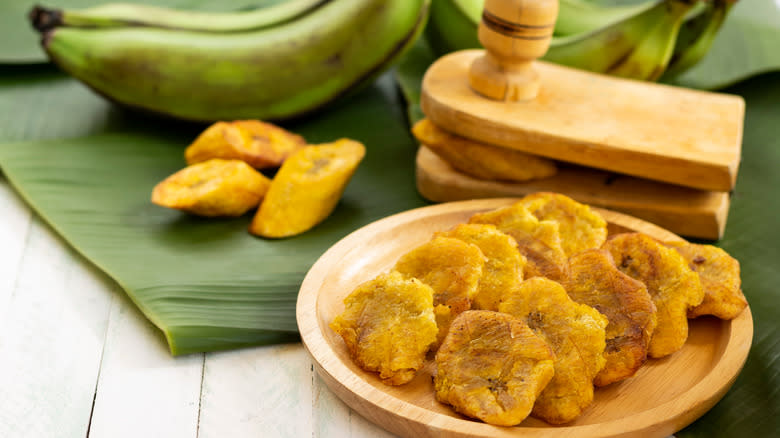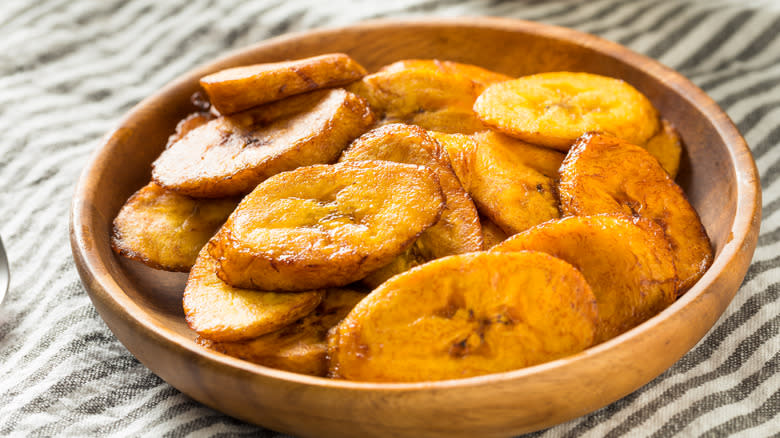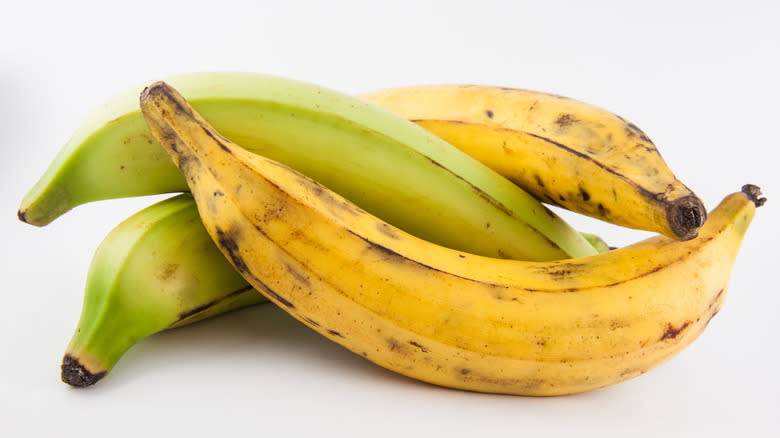Maduros Vs Tostones: What Makes The Fried Plantain Treats So Different

Plantains are a tropical staple that deserve more love. Although they are originally from Southeast Asia, they were brought by the Spanish to the Caribbean, where they have since become woven into the very fabric of Caribbean cuisine. They look like bananas but aren't as sweet, which makes them more versatile in the kitchen. The caveat is that plantains aren't very good raw. Luckily, there are plenty of ways to prepare them. One of the most popular methods is to fry them. They've got all of the appeal of a french fry while adding a tropical twist, and it's hard not to feel the sunshine on your face as you bite down.
Believe it or not, there's more than one way to fry plantains. We'll be looking at two must-try plantain dishes: maduros and tostones. Although they use the same ingredients and have a similar cooking process, these two Caribbean favorites are different enough to justify having their own names. Whether you're a plantain newbie or a lifelong devourer, the difference between the two fried plantain treats isn't immediately obvious. So, what is the difference, and how do we get our hands on some?
Read more: 13 Simple Tricks To Pick The Best Fresh Fruit Every Time
What Are Maduros?

The recipe for Maduros traveled from India to Central America when plantains were first introduced to the region. Today, the dish is commonly associated with Cuba but remains popular in Southern Indian cuisine and is enjoyed all over the Caribbean and Latin America as well. The word maduro means mature in Spanish, which is a reference to how ripe the plantain is that's used to make maduros. And when we say ripe, we mean really ripe. As a plantain ripens it starts off green before turning yellow and finally black, similar to a banana's arc of maturity. A true plate of maduros is made with plantains that are as black as night, well beyond their prime and getting close to spoiled territory. At this point, most of the plantain's starches have been converted into sugar, so the flesh is as sweet as it can possibly get.
The lack of starch means that, despite being fried, the finished product is typically mushy like a custard. The flavor profile is a lovely salty-sweet, but not so sweet as to be relegated to the dessert menu. Often eaten on their own with some salt sprinkled on top, maduros also go well dipped in a homemade aji verde sauce or other citric dip.
What Are Tostones?

Tostones are the more savory kind of fried plantain. Its origins remain something of a mystery, but it likely gets its name from the colonial Spanish-era currency: the Tostón. That may have something to do with them looking like gold coins, but it's hard to say for certain. Regardless, they are eaten all over the region, though they go by different names. It's not uncommon to hear them referred to as patacones in places like Colombia and Ecuador.
There are really two things that make a tostone a tostone. The first is that you have to use green plantains. It's going to be more difficult to get the fruit out of the peel, but that's what knives are for. Most of the starch hasn't been turned into sugar yet, so it's on the more savory side. The second thing about tostones is that they are crispier than maduros. This is due to the higher starch content, which crisps up a lot more when fried compared to sugar. That's why french fries are so crispy: Potatoes have a lot of starch.
Sometimes eaten on their own, tostones are also great with spreads or dips. Black bean dip, guacamole, and aji verde all make great partners. If served as a side dish, they can also be used to scoop up spicy stews or hearty rice dishes.
Maduros Are Much Sweeter

If you had no idea what maduros or tostones were and you blind tasted them, the most obvious difference in flavor would probably be the sweetness. Because maduros are made with extra ripe plantains — after the starch has turned to sugar — there's really no comparison with the under-ripe green plantains of tostones. You'll still be getting a similar plantain flavor in both, but the caramelization that happens to the fried sugars in maduros is going to set it apart.
As you may imagine, this has an impact on how the dishes are served. Although there is enough salty savoriness in maduros to pair well with citric dips like the aji verde, the sweetness keeps it from having the same side-dish versatility of tostones. Maduros can be served as sides to savory rice, beans, and meat mains, but tostones are mild enough to pair well with a wider array of flavor profiles.
Tostones Are Fried Twice

Just as important as how ripe the plantains are is how these dishes are made. Something unusual about tostones is that they are fried two times. They are fried once right after slicing them, then they're pulled out, smashed into flat disks, and fried again. The smashing and refrying accomplishes two things: It makes them bigger but, more importantly, it increases the surface area the oil has access to, which ramps the crispness of the tostones way up.
It's not very often you see a recipe that calls for frying twice. If you didn't need to smash the plantain in between, it would make more sense to simply keep the food in the fryer for longer rather than remove it and put it back in. The shortcut would be to smash the plantain before placing it in the oil the first time, but you wouldn't achieve the iconic tostone crunch without both trips into the fryer.
Maduros, on the other hand, are only fried once. Some recipes recommend a slow-frying process, but others are more straightforward. Even if you fried maduros for longer, they wouldn't achieve the same texture as tostones due to their lack of starch. One last differentiating fun fact: Maduros are often sliced diagonally to give the plantain a unique look.
Read the original article on Tasting Table.

